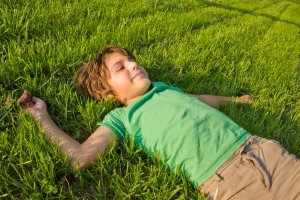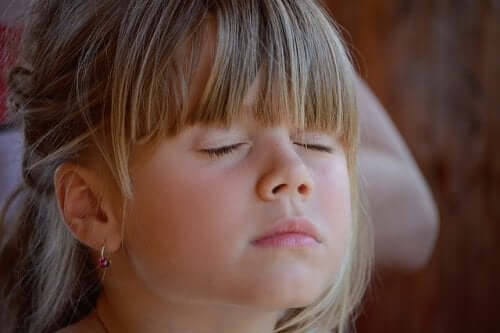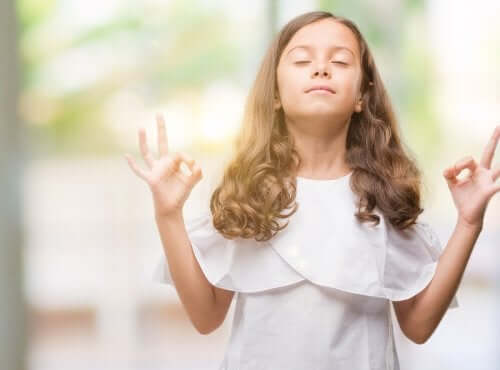The Importance of Relaxation in Children

In this day and age, children grow up surrounded by constant stimuli and remain excessively active most of the time. However, to develop properly, having peaceful and quiet times to rest is fundamental. Therefore, in today’s article, we want to talk about the importance of relaxation in children.
Relaxing consists of achieving a state of physical and mental rest through diverse techniques and exercises. The benefits are numerous when it comes to a child’s health and emotional intelligence. At the same time, it encourages learning and social relationships.
“Seek peace for your mind and you will find health for your body.”
– Anonymous –
The importance of relaxation in children
Today’s children are born into what we call “stress society.” This means that people, in general, live in a constant state of hurry and acceleration as a way of life. This can cause major emotional distress and even psychological problems.
Therefore, it’s imperative that children learn to care for their physical and mental health from a very young age. And this means teaching them techniques and methods of infant relaxation. What’s more, it’s not uncommon to encounter children who become nervous when studying and when the time comes to take a test. In these cases, stress, worry, and anxiety can cause them to forget the knowledge they worked so hard to learn.

This explains why low academic performance often has nothing to do with the learning of content. Rather, it has to do with children’s inability to stay calm when writing or verbalizing what they’ve learned. In that sense, relaxation in children is useful when it comes to studying and achieving improved academic performance.
The objectives of relaxation in children
The importance of relaxation in children resides in its benefits, which are both physiological and psychological. In fact, we can say that relaxation techniques are ideal for achieving the following objectives:
- Producing positive emotions.
- Improving cognitive abilities.
- Increasing personal wellbeing.
- Reducing anxiety, stress, and aggression.
- Increasing awareness of their own bodies.
- Improving self-control.
Guidelines for carrying out relaxation in children
To help children relax, there needs to be an adult in charge who can explain the objectives and guide little ones in the process. In this sense, you should follow the steps below:
- Ask children to get into position. This means sitting in a chair with their backs straight. Or, they can opt to lay down comfortably on a bed or couch.
- Tell them to close their eyes while relaxing music plays in the background.
- Ask children to breathe deeply and focus their attention on the music.
- Gradually instruct them in tension-relaxation exercises involving the different parts of their bodies. They should repeat each exercise three times, resting for a few seconds between repetitions. We suggest the following order:
- Arms and hands: Without moving, contract your muscles in one arm and then the other, with a tight first. Notice the tension, and then slowly relax.
- Forehead: Scrunch your forehead for a few seconds and then relax.
- Nose: Wrinkle your nose for a few seconds and then relax.
- Mouth: Make a big smile and then relax.

-
- Tongue: Press your tongue against the roof of your mouth and relax.
- Jaw: Clench your teeth and take note of the tension in the lateral muscles of your face. Relax.
- Lips. Pucker your lips as if you were going to give a kiss and then relax.
- Neck: Slowly stretch your neck backward and then return to the original position. Now, stretch your neck forward and slowly return to the original position.
- Shoulders, chest, and back: Roll your shoulders back towards your shoulder blades.
- Stomach: Tighten your stomach and then slowly relax.
- Legs: Stretch one leg and then the other by lifting your feet upwards. Slowly relax.
- Following these exercises, children should imagine a pleasant scene and then let the scene take them away for a few minutes.
- Ask them to slowly open their eyes, counting backward from 5.
More tips for relaxation in children
- Pay attention to their own breathing.
- Guide their thoughts and feelings.
- Remain patient.
- Control their impulses.
What’s more, it’s worth pointing out that relaxation should be applied as many times as necessary. But, it’s especially convenient to practice relaxation at times when your kids are anxious or having a hard time concentrating. That way, you can help them calm down and rest.
In this day and age, children grow up surrounded by constant stimuli and remain excessively active most of the time. However, to develop properly, having peaceful and quiet times to rest is fundamental. Therefore, in today’s article, we want to talk about the importance of relaxation in children.
Relaxing consists of achieving a state of physical and mental rest through diverse techniques and exercises. The benefits are numerous when it comes to a child’s health and emotional intelligence. At the same time, it encourages learning and social relationships.
“Seek peace for your mind and you will find health for your body.”
– Anonymous –
The importance of relaxation in children
Today’s children are born into what we call “stress society.” This means that people, in general, live in a constant state of hurry and acceleration as a way of life. This can cause major emotional distress and even psychological problems.
Therefore, it’s imperative that children learn to care for their physical and mental health from a very young age. And this means teaching them techniques and methods of infant relaxation. What’s more, it’s not uncommon to encounter children who become nervous when studying and when the time comes to take a test. In these cases, stress, worry, and anxiety can cause them to forget the knowledge they worked so hard to learn.

This explains why low academic performance often has nothing to do with the learning of content. Rather, it has to do with children’s inability to stay calm when writing or verbalizing what they’ve learned. In that sense, relaxation in children is useful when it comes to studying and achieving improved academic performance.
The objectives of relaxation in children
The importance of relaxation in children resides in its benefits, which are both physiological and psychological. In fact, we can say that relaxation techniques are ideal for achieving the following objectives:
- Producing positive emotions.
- Improving cognitive abilities.
- Increasing personal wellbeing.
- Reducing anxiety, stress, and aggression.
- Increasing awareness of their own bodies.
- Improving self-control.
Guidelines for carrying out relaxation in children
To help children relax, there needs to be an adult in charge who can explain the objectives and guide little ones in the process. In this sense, you should follow the steps below:
- Ask children to get into position. This means sitting in a chair with their backs straight. Or, they can opt to lay down comfortably on a bed or couch.
- Tell them to close their eyes while relaxing music plays in the background.
- Ask children to breathe deeply and focus their attention on the music.
- Gradually instruct them in tension-relaxation exercises involving the different parts of their bodies. They should repeat each exercise three times, resting for a few seconds between repetitions. We suggest the following order:
- Arms and hands: Without moving, contract your muscles in one arm and then the other, with a tight first. Notice the tension, and then slowly relax.
- Forehead: Scrunch your forehead for a few seconds and then relax.
- Nose: Wrinkle your nose for a few seconds and then relax.
- Mouth: Make a big smile and then relax.

-
- Tongue: Press your tongue against the roof of your mouth and relax.
- Jaw: Clench your teeth and take note of the tension in the lateral muscles of your face. Relax.
- Lips. Pucker your lips as if you were going to give a kiss and then relax.
- Neck: Slowly stretch your neck backward and then return to the original position. Now, stretch your neck forward and slowly return to the original position.
- Shoulders, chest, and back: Roll your shoulders back towards your shoulder blades.
- Stomach: Tighten your stomach and then slowly relax.
- Legs: Stretch one leg and then the other by lifting your feet upwards. Slowly relax.
- Following these exercises, children should imagine a pleasant scene and then let the scene take them away for a few minutes.
- Ask them to slowly open their eyes, counting backward from 5.
More tips for relaxation in children
- Pay attention to their own breathing.
- Guide their thoughts and feelings.
- Remain patient.
- Control their impulses.
What’s more, it’s worth pointing out that relaxation should be applied as many times as necessary. But, it’s especially convenient to practice relaxation at times when your kids are anxious or having a hard time concentrating. That way, you can help them calm down and rest.
All cited sources were thoroughly reviewed by our team to ensure their quality, reliability, currency, and validity. The bibliography of this article was considered reliable and of academic or scientific accuracy.
- López-González, L. (2012). Relajación en el aula: recursos para la educación emocional. Madrid: Wolters Kluwer España.
- Mármol, A. G. (2013). La relajación en niños: principales métodos de aplicación. EmásF: revista digital de educación física, (24), 35-43.
- Snel, E. (2013). Tranquilos y atentos como una rana. Barcelona: Editorial Kairós.
This text is provided for informational purposes only and does not replace consultation with a professional. If in doubt, consult your specialist.








